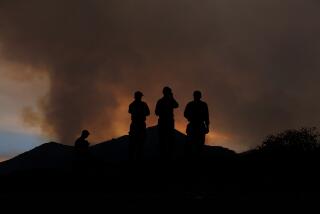Evacuations rise as wildfires gain ground in Colorado and Utah
- Share via
More than 3,500 homes in two Western states were under wildfire evacuation orders Saturday as flames gained ground in the canyons of northern Colorado and a new blaze devoured sagebrush in Utah, officials said.
Authorities believe the Utah blaze, called the Dump fire, was sparked when a bullet grazed a rock on public land near a landfill popular as an unofficial shooting range.
The fire tore through more than 6,000 acres of grassland near Utah Lake, about 45 minutes south of Salt Lake City. About 40,000 people live in the area near Saratoga Springs and Eagle Mountain.
Crews struggled Saturday against heat and wind, trying to keep the fire away from power lines, media towers and hundreds of homes. Nearly 600 evacuation orders are in place affecting an estimated 2,300 people.
“It’s like being hit by a blow dryer,” said Cami Lee, a spokeswoman for the U.S. Bureau of Land Management. “So incredibly hot and windy.”
Difficulties posed by the weather and steep, rocky terrain have been compounded by unseasonable dryness. A mild winter and lack of rainfall have left the moisture in the sagebrush around Utah Lake closer to levels usually seen in August, Lee said.
The High Park fire, the most destructive in Colorado history, grew by more than 5,000 acres from Friday to Saturday, destroying nearly a dozen homes and forcing 1,000 more evacuations, officials said. The flames have charred nearly 120 square miles of rugged canyon and pine forests near the Roosevelt National Forest since lightning sparked the blaze June 9. Containment slipped from 60% to 45%.
“That’s significant growth for one day,” Reid Armstrong, a U.S. Forest Service spokeswoman, told The Times. “With this kind of weather conditions, if the fire got past one of our containment lines, it could make a huge run, just like that.”
Firefighters continued to battle in what had been the most unstable area, on the fire’s western flank. Flames jumped from treetop to treetop in the Roosevelt National Forest, scorching forests weakened by mild winters and beetle infestations.
The main fire west of Fort Collins, Colo., jumped what had been the best-defended boundary and joined forces with two smaller spot fires earlier this week. Saturday, the combined flames raced across Highway 14 and the Poudre Canyon toward mountain ranges to the north.
After earlier fires there faded, the U.S. Forest Service told Poudre Canyon residents they could go home. But less than 24 hours later, residents were evacuated again.
“It’s easy, when you’re in a situation for 14 days, to start relaxing,” Armstrong said. “We have a lot of antsy homeowners who want to go back to their homes. Just yesterday, it was proved that it can change on a dime.”
ALSO:
Jerry Sandusky case raised awareness of sexual abuse
Juror on Jerry Sandusky’s crimes: “He knew it was true”
Attorney of Jerry Sandusky victim says, “He’s feeling elated”
laura.nelson@latimes.com
Follow Laura on Twitter.
More to Read
Sign up for Essential California
The most important California stories and recommendations in your inbox every morning.
You may occasionally receive promotional content from the Los Angeles Times.











